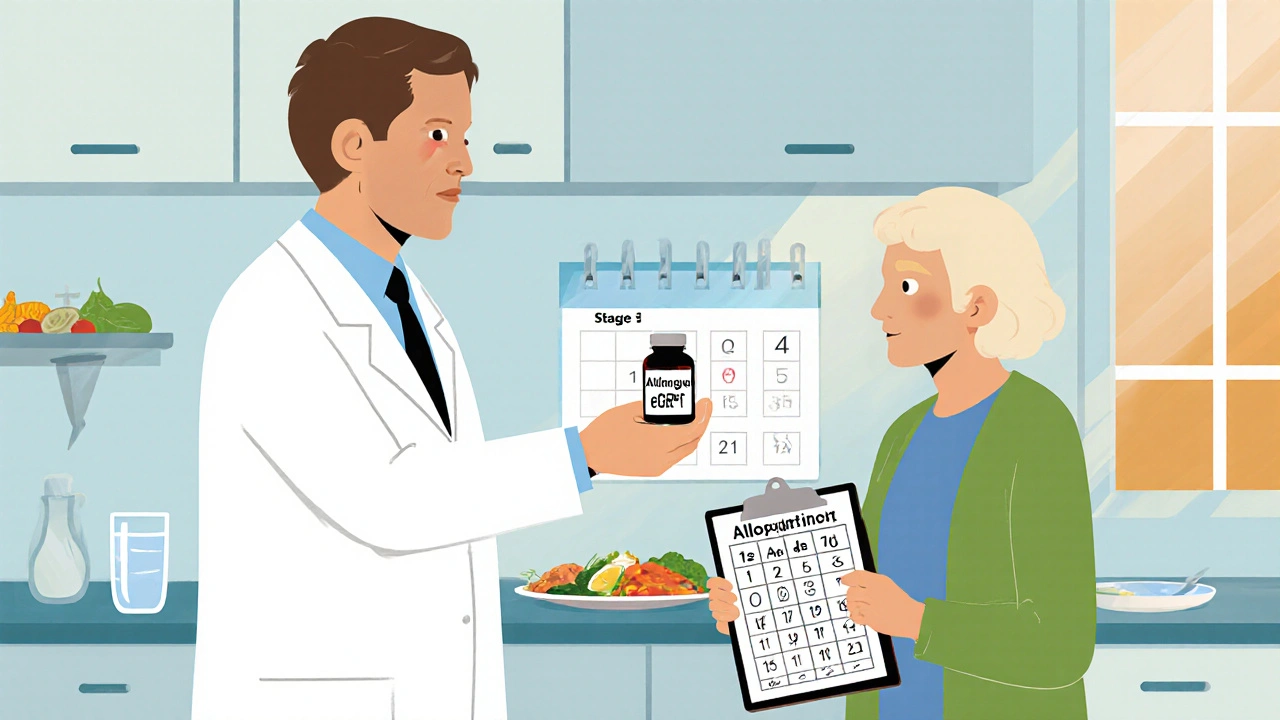Quick Takeaways
- Allopurinol lowers uric acid by inhibiting xanthine oxidase, which can slow CKD progression in patients with hyperuricemia.
- Typical dosing starts at 100 mg daily and is adjusted based on eGFR to avoid accumulation.
- Clinical trials show modest reductions in serum creatinine and proteinuria when allopurinol is added to standard CKD therapy.
- Common side‑effects include rash and rare severe hypersensitivity; regular labs are essential.
- Allopurinol works best when combined with blood‑pressure control, SGLT2 inhibitors, and lifestyle changes.
When you hear the word allopurinol you probably think of gout, but doctors have been looking at it for kidney health for decades. Chronic kidney disease (CKD) affects more than 37 million adults in the United States, and many of them also have high uric acid levels. The big question is: can a gout drug actually protect the kidneys? This article breaks down the science, the evidence, and the practical steps you need if you or a loved one are considering allopurinol for CKD.
Allopurinol is a xanthine oxidase inhibitor that reduces serum uric acid by blocking its production. It was first approved in 1966 for gout and later received attention for possible renal benefits. The drug works at the biochemical level, but its impact on long‑term kidney outcomes depends on many factors: stage of CKD, presence of hyperuricemia, other medications, and patient genetics.
How Allopurinol Works in the Kidneys
The kidneys filter and excrete uric acid, but when glomerular filtration drops, uric acid builds up, leading to crystal deposition and inflammation. Allopurinol targets the enzyme Xanthine Oxidase, which converts hypoxanthine to xanthine and then to uric acid. By inhibiting this step, allopurinol reduces the amount of uric acid that reaches the kidneys.
Beyond uric‑acid lowering, research points to three secondary mechanisms that may benefit CKD:
- Reduced oxidative stress: Xanthine oxidase also generates reactive oxygen species; blocking it cuts oxidative damage to renal tubules.
- Improved endothelial function: Lower uric acid correlates with better nitric‑oxide availability, aiding blood‑flow regulation.
- Decreased inflammation: Less uric‑acid crystal formation means fewer inflammatory cytokines like IL‑1β.
What the Evidence Says
Multiple randomized controlled trials (RCTs) and meta‑analyses have examined allopurinol in CKD patients with hyperuricemia. A 2022 meta‑analysis of 12 RCTs (≈1,800 participants) found that allopurinol reduced the annual decline in estimated glomerular filtration rate (eGFR) by 2.1 mL/min/1.73 m² compared with placebo. Proteinuria, a marker of kidney damage, dropped by an average of 19 %.
Key studies to note:
- CKD‑ALL Study (2021): 300 patients with stage 3‑4 CKD and serum uric acid > 7 mg/dL received 300 mg daily of allopurinol. After 24 months, eGFR decline slowed from 4.3 mL/min/yr (placebo) to 2.1 mL/min/yr.
- PERL Trial (2020): Focused on diabetic kidney disease; allopurinol (up to 300 mg) modestly improved eGFR but did not change cardiovascular outcomes.
- Observational Cohort (2023): Over 5 years, patients on allopurinol had a 22 % lower risk of reaching end‑stage renal disease (ESRD) than matched controls.
While the data are promising, the effect size is modest and benefits are most consistent in patients with baseline hyperuricemia (> 6 mg/dL). Allopurinol is not a cure; it should be part of a broader CKD management plan.

Dosing Allopurinol for Impaired Kidneys
Kidney function dictates how quickly allopurinol and its active metabolite oxypurinol accumulate. Over‑dosing raises the risk of severe hypersensitivity syndrome, especially in patients with eGFR < 30 mL/min/1.73 m². Below is a practical dosing table that aligns with current nephrology guidelines (KDIGO 2024).
| CKD Stage (eGFR) | Starting Dose | Maximum Dose | Adjustment Frequency |
|---|---|---|---|
| 1‑2 (≥90) | 100 mg daily | 300 mg daily | Every 2‑4 weeks |
| 3 (30‑59) | 100 mg daily | 200 mg daily | Every 2 weeks |
| 4 (15‑29) | 50 mg daily | 100 mg daily | Weekly |
| 5 (<15) or dialysis | 50 mg every other day | 50 mg every other day | Weekly labs |
Always check serum uric acid 2‑4 weeks after a dose change and monitor liver enzymes and complete blood count for signs of hypersensitivity.
Benefits and Risks in Real‑World Use
Potential benefits
- Slower eGFR decline, especially in hyperuricemic patients.
- Reduced proteinuria, which translates to lower cardiovascular risk.
- Lower incidence of gout attacks - a common comorbidity in CKD.
- Possible decrease in dialysis initiation rates when used early.
Key risks
- Skin rash or severe Stevens‑Johnson‑like reactions (allopurinol hypersensitivity syndrome). Risk climbs with higher oxypurinol levels.
- Hepatotoxicity - monitor ALT/AST every 3‑6 months.
- Drug interactions: avoid concurrent high‑dose azathioprine, mercaptopurine, or didanosine without dose adjustment.
- Potential for over‑lowering uric acid (< 2 mg/dL), which may affect antioxidant defenses.
Patients with the HLA‑B*58:01 allele are at markedly higher risk for hypersensitivity; genetic testing is recommended for Asian ancestry before starting therapy.

Practical Tips for Patients and Clinicians
- Start low, go slow - especially if eGFR < 30 mL/min/1.73 m².
- Stay hydrated; adequate fluid intake helps uric acid excretion.
- Avoid high‑purine foods (red meat, organ meats, certain seafood) and sugary drinks.
- Schedule lab checks: serum uric acid, creatinine, ALT/AST, CBC at baseline, 2 weeks, then every 3 months.
- Educate patients on early signs of rash or fever - prompt discontinuation can be lifesaving.
- Combine with guideline‑based CKD therapies: ACE inhibitors/ARBs, SGLT2 inhibitors, and blood‑pressure control.
Quick Checklist Before Starting Allopurinol
- Confirm eGFR and stage of CKD.
- Measure baseline serum uric acid.
- Screen for HLA‑B*58:01 if patient is of Asian descent.
- Review current meds for interactions (azathioprine, mercaptopurine).
- Discuss lifestyle measures (diet, hydration).
- Set a lab monitoring schedule.
Frequently Asked Questions
Can allopurinol stop CKD progression?
Allopurinol can slow the rate of decline in eGFR, especially in patients with high uric acid. It does not reverse existing damage, so it works best as part of a comprehensive CKD plan.
What dose is safe for someone on dialysis?
A typical regimen is 50 mg every other day, with close monitoring of uric acid and signs of toxicity. Some clinicians prefer 50 mg daily, but the key is to avoid accumulation.
Are there natural ways to lower uric acid instead of medication?
Yes - staying well‑hydrated, limiting purine‑rich foods, and reducing fructose intake can lower uric acid modestly. However, in CKD patients with markedly elevated levels, diet alone often isn’t enough.
How quickly should I see a drop in uric acid after starting allopurinol?
Serum uric acid usually falls within 1‑2 weeks of reaching a therapeutic dose. If the reduction is less than 30 % after 4 weeks, the dose may need adjustment.
What should I do if I develop a rash while on allopurinol?
Stop the medication immediately and contact your healthcare provider. A rash could signal the start of hypersensitivity syndrome, which requires urgent treatment and avoidance of allopurinol in the future.
Allopurinol isn’t a magic bullet, but for many patients with CKD and high uric acid, it adds a useful layer of protection. Pair it with proven kidney‑saving drugs, keep labs in check, and stay alert to side‑effects. Talk to your nephrologist to see if it fits your treatment plan.


Shannon Stoneburgh
October 24, 2025 AT 21:14Allopurinol sounds like a gimmick for kidney patients with high uric acid. The data barely moves the needle.
Nathan Comstock
November 4, 2025 AT 04:06Listen, the science is crystal clear-if you don’t lower uric acid you’re basically inviting renal failure. Everyone who ignores this is living in the past!
Corrine Johnson
November 14, 2025 AT 10:57Consider, dear reader, the paradox of a gout drug becoming a renal guardian; is it not a testament to the interconnectedness of human biochemistry, and yet, does it not also reveal the limitations of our reductionist approaches?
Jennifer Stubbs
November 24, 2025 AT 17:49The mechanisms you cite are interesting, but the clinical impact remains modest; we need larger trials before heralding it as a breakthrough.
Abby W
December 5, 2025 AT 00:40Hey folks 😅 just saw this and thought, why not toss a few emojis in a kidney talk? Allopurinol might help, but don’t forget diet and water!